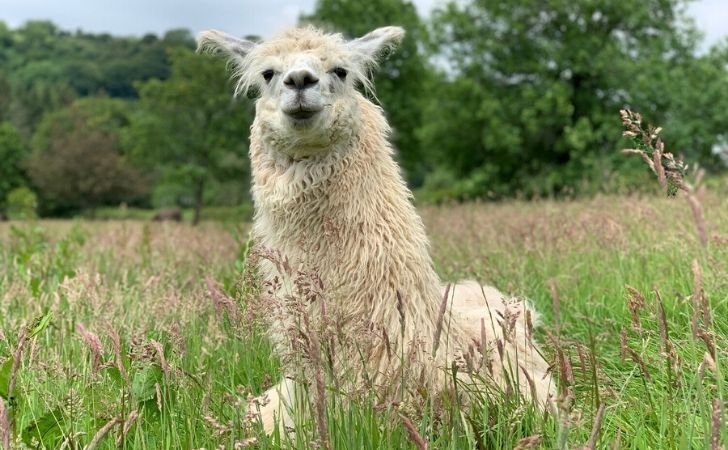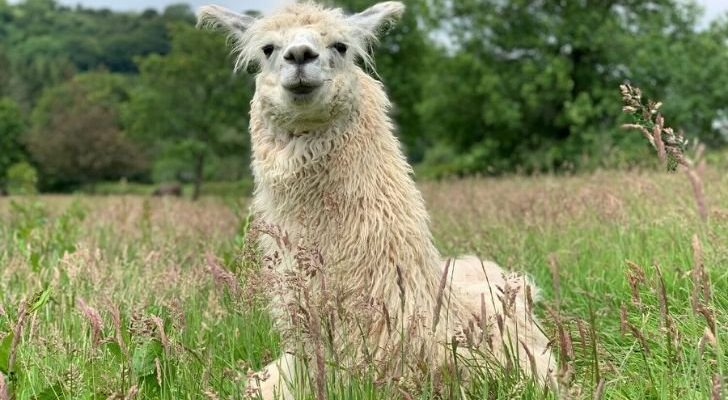
Imagine you’re sitting in a cozy café, sipping on your favorite drink, and someone starts sharing stories about their pet llama. You’d likely hear about their *spitting* antics, the soft *humming* sounds they make, and the special *bonding* they experience with humans and other llamas. Each of these behaviors has a purpose and learning about them can help us connect with these wonderful animals on a whole new level.
The Basics of Llama Communication
Llamas have a whole repertoire of behaviors that they use to communicate with each other and with us. This is important because these sounds and actions can tell us how they’re feeling or what they need. It’s kind of like having a conversation without words!
You might be surprised to learn that llamas are quite vocal. They hum to express a range of emotions or messages. When a llama hums, it can mean anything from contentment to anxiety. It’s their way of saying “Hey, I’m here!” or “I’m not so sure about this.” The pitch and tone of their hum can provide even more context. For instance, a low hum might indicate relaxation, while a higher pitch might signal distress.
Another key part of llama communication is their body language. They use their ears, stance, and even tail position to express feelings. When a llama tilts its ears forward, it’s usually curious or interested in something. On the other hand, if you see a llama with its ears pinned back, it might be feeling defensive or threatened. Paying attention to these cues can help you understand what your llama is trying to communicate.
Why Do Llamas Spit?
Ah, the infamous llama spit! It’s one of the most talked-about aspects of their behavior, and for good reason. Many people wonder, “Why on earth would a llama spit?” Well, here’s the scoop: llamas don’t just spit randomly; it’s usually a reaction to stress, annoyance, or to assert dominance.
When llamas feel threatened or challenged, they might resort to spitting to establish boundaries. This is especially common during feeding time if they feel like another llama is trying to steal their food. It’s their way of saying, “Back off! This is mine!” In fact, you’ll often see a llama spit at another who’s invading their personal space. It’s their version of a “stay away” sign.
But that’s not the only reason they spit. Llamas also use spitting in social interactions. Sometimes, a llama might spit at a human who gets too close during feeding or when it’s feeling a bit cranky. It’s important to respect their space and understand that spitting is just one of their ways of communicating discomfort. Think of it like a child pouting or throwing a tantrum—sometimes, they just need their space.
The Fascinating Sound of Humming
As mentioned earlier, humming is a key part of llama communication. It seems simple, but this sound carries a lot of meaning! Llamas hum when they’re curious, calm, or even when they are trying to talk to their friends. If you hear a gentle hum while you’re near llamas, they’re likely just feeling content or relaxed.
Interestingly, *humming* can vary in pitch and tone, which adds to its complexity. For instance, a soft, rhythmic hum could indicate that a llama is happy and at ease in its environment. Conversely, a more erratic or high-pitched hum might mean that the animal is feeling anxious or uncertain. By tuning into these subtle differences, we can better understand how a llama is feeling at any given moment.
Also, llamas often hum not just when they’re alone, but in social gatherings, especially when they’re forming connections with each other. Imagine a group of friends chatting softly to each other—this is similar to what llamas do! It’s their way of staying in touch within their social group.
The Importance of Social Bonding in Llamas
Llamas are social animals, and bonding is crucial for their well-being. They thrive in groups and often develop strong relationships with one another. The bonds they form can be quite special; they often engage in mutual grooming, which helps deepen their connections and reinforces their social structures.
Bonding doesn’t just happen between llamas. They can also bond with humans! If you spend time with a llama—feeding it, petting it, or just being present—they learn to trust you and often come to enjoy your company. You might even find that your llama hums contentedly when you’re around; that’s a good sign that the bond is forming!
The bond between llamas can be a fascinating thing to observe. They often show protective behaviors towards each other, standing guard or nudging a friend to make sure they’re okay. This social instinct is part of what makes llamas such wonderful companions.
How to Build a Strong Bond with Your Llama
If you’re lucky enough to have a llama of your own or have the chance to interact with one, building a bond requires patience and understanding. Here are a few tips to help you connect with your llama:
- Spend Time Together: Just like any friendship, spending quality time is key. Sit with your llama, let them approach you, and get comfortable.
- Consistency is Key: Feed them at the same time every day. This creates a routine that they can look forward to.
- Use Positive Reinforcement: Reward your llama with treats or gentle praise when they exhibit friendly behaviors. This encourages more of the same.
- Be Patient: Llamas may take time to warm up to you. They’re not unfriendly; they just like to take their time getting to know you.
Just remember, every llama is unique, and some may take longer to bond than others. The important thing is to be gentle and respectful of their space and emotions.
Learning about llama behavior—from their spitting and humming to their deep social bonds—offers a glimpse into the heart of these amazing creatures. It’s like opening a window into their world, where communication goes beyond words, and relationships matter. Whether you’re hoping to bond with a pet llama or just curious about these fascinating animals, understanding their behaviors can help enhance your experience.
So, the next time you see a llama, take a moment to watch their interactions. You might notice a hum or see a spit—and now you know what it all means. Embrace the unique quirks of llamas, and you may just find a new appreciation for these lovable creatures!

